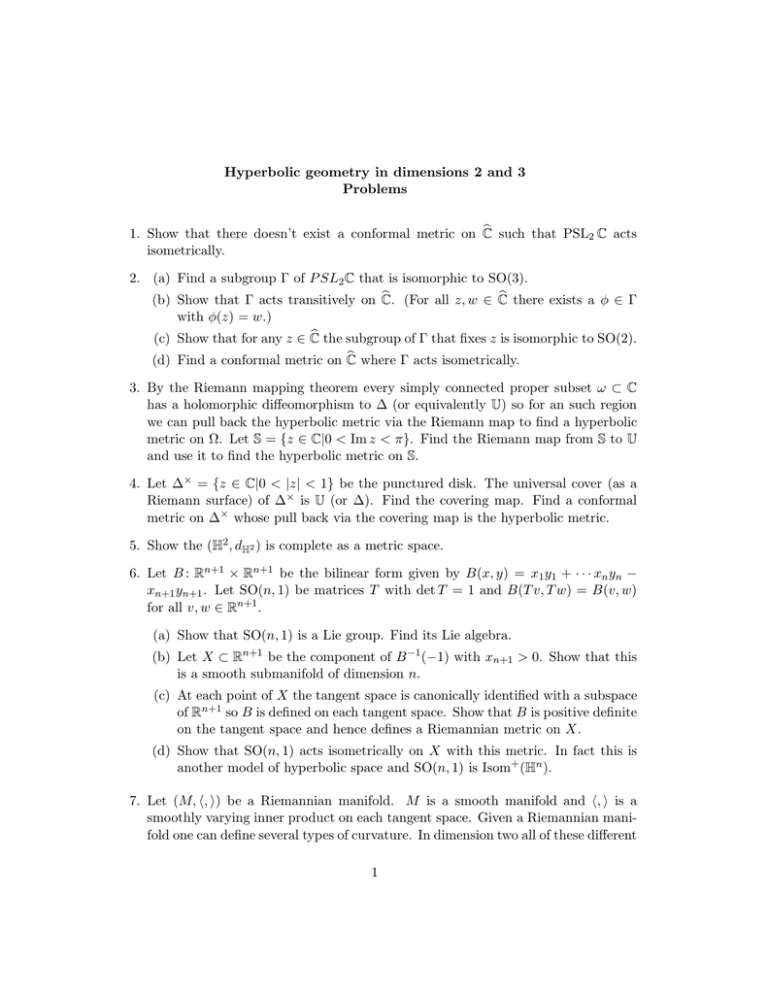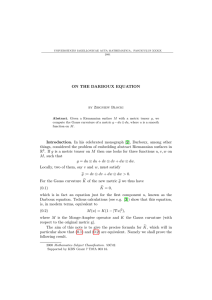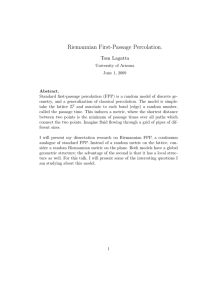Hyperbolic geometry in dimensions 2 and 3 Problems C such that PSL
advertisement

Hyperbolic geometry in dimensions 2 and 3
Problems
such that PSL2 C acts
1. Show that there doesn’t exist a conformal metric on C
isometrically.
2. (a) Find a subgroup Γ of P SL2 C that is isomorphic to SO(3).
(For all z, w ∈ C
there exists a φ ∈ Γ
(b) Show that Γ acts transitively on C.
with φ(z) = w.)
the subgroup of Γ that fixes z is isomorphic to SO(2).
(c) Show that for any z ∈ C
where Γ acts isometrically.
(d) Find a conformal metric on C
3. By the Riemann mapping theorem every simply connected proper subset ω ⊂ C
has a holomorphic diffeomorphism to ∆ (or equivalently U) so for an such region
we can pull back the hyperbolic metric via the Riemann map to find a hyperbolic
metric on Ω. Let S = {z ∈ C|0 < Im z < π}. Find the Riemann map from S to U
and use it to find the hyperbolic metric on S.
4. Let ∆× = {z ∈ C|0 < |z| < 1} be the punctured disk. The universal cover (as a
Riemann surface) of ∆× is U (or ∆). Find the covering map. Find a conformal
metric on ∆× whose pull back via the covering map is the hyperbolic metric.
5. Show the (H2 , dH2 ) is complete as a metric space.
6. Let B : Rn+1 × Rn+1 be the bilinear form given by B(x, y) = x1 y1 + · · · xn yn −
xn+1 yn+1 . Let SO(n, 1) be matrices T with det T = 1 and B(T v, T w) = B(v, w)
for all v, w ∈ Rn+1 .
(a) Show that SO(n, 1) is a Lie group. Find its Lie algebra.
(b) Let X ⊂ Rn+1 be the component of B −1 (−1) with xn+1 > 0. Show that this
is a smooth submanifold of dimension n.
(c) At each point of X the tangent space is canonically identified with a subspace
of Rn+1 so B is defined on each tangent space. Show that B is positive definite
on the tangent space and hence defines a Riemannian metric on X.
(d) Show that SO(n, 1) acts isometrically on X with this metric. In fact this is
another model of hyperbolic space and SO(n, 1) is Isom+ (Hn ).
7. Let (M, , ) be a Riemannian manifold. M is a smooth manifold and , is a
smoothly varying inner product on each tangent space. Given a Riemannian manifold one can define several types of curvature. In dimension two all of these different
1
types of curvature conicide. An exercise that every graduate student should do is
to calculate the curvature in the hyperbolic plane.
To do this we rapidly discuss (without proof) some basic notions in Riemannian
geometry. We begin with the Riemannian connection. This is map
∇ : Λ(M ) × Λ(M ) → Λ(M )
where Λ(M ) is the space of smooth vector fields on the Riemannian manifold M .
It is usually written ∇Y X and satisfies the following properties:
(a) ∇f Y +gZ X = f ∇Y X + g∇Z X;
(b) ∇Y (f X + Z) = (∇Y f )X + f ∇Y X + ∇Y Z;
(c) ∇X Y − ∇Y X = [X, Y ];
(d) ∇X Y, Z = ∇X Y, Z + X, ∇X Z
(Here ∇X f is the directional derivative of the function f in the direction X.) It
is a fundamental result that every Riemannian metric has a unique Riemannian
connection and there is a formula for it in a local chart. The standard vector fields
E1 , . . . , En in Rn define vector fields on the charts and then gij = Ei , Ej are
smooth functions on the chart. If we think of the gij as being the coordinates of
a matrix we can let gij be the coordinates of the inverse matrix. The Riemannian
connection is determined by its values on a basis. (This follows
from (a) and (b)).
k
Let Γij be smooth functions on the chart such that ∇Ei Ej = k Γkij Ek . The Γkij
are Christoffel symbols and they are given by the formula
∂gij
1 ∂gim ∂gjm
k
+
−
gmk .
Γij =
2 m
∂xj
∂xi
∂xm
The curvature operator is a map from Λ(M ) × Λ(M ) to the space of bundle maps
from T M to itself. It is defined by
R(X, Y ) = ∇Y ∇X − ∇X ∇Y + ∇[X,Y ] .
At each point p ∈ M , R(X, Y ) is a linear map from Tp M to itself. If Z ∈ Λ(M )
is a third vector field then R(X, Y )Z is a vector field. If we have a fourth vector
field W ∈ Λ(M ) then R(X, Y )Z, W is a smooth function on M . In an abuse
of notation we write R(X, Y, Z, W ) = R(X, Y )Z, W . We can now define the
sectional curvature. This is a function on two-dimensional planes in the tangent
space at a point p. In particular if P is a plane in Tp M then we choose vector
fields X and Y such that X and Y are a basis for P at p. Two vectors span a
2
parallelogram. Let A(X, Y ) be the area of this parallelogram. Then the sectional
curvature κ(P ) is the value of R(X, Y, X, Y )/(A(X, Y ))2 at p. A fundamental
result is that κ(P ) only depends on P and not the choice of X and Y .
Of course, there are many things that have been left unproved. They are not especially difficult; the difficulty is making the right definitions. A standard reference
is do Carmo’s book on Riemannian geometry. Another more concise reference is
Milnor’s Morse Theory book. Assuming everything that has been written is true
we can now make some calculations for the hyperbolic plane.
(a) Calculate Γkij for the hyperbolic metric in both U and ∆.
(b) Calculate the sectional curvature of the hyperbolic plane.
8. Let α : I → M be a smooth path. We would like to define ∇α α . However, ∇ is
only defined for vector fields define on all of M (or at least an open subset of M )
so to define ∇α α we need to extend α to an open neighborhood. However, then
we need to check that if X and X are different extensions of α then ∇X X and
∇X X agree along the image of α.
To see that his holds we observe the following: The vector field ∇X Y at p ∈ M
only depends on Y and the value of X at p. (This follows from property (a) of the
Riemannian connection.) In particular if X and X agree at p then so does ∇X Y
and ∇X Y . If α : I → M is a path through p ∈ M with tangent vector equal to
Y at p and Y is another vector field that agrees with Y on the image of α then
again we have that ∇X Y and ∇X Y agree at p. It follows that any extension X of
α will always give the same values on the image of α and ∇α α .
A geodesic on a Riemannian manifold is a smooth curve α with ∇α α = 0. In
general the size of ∇α α measure the geodesic curvature of α.
(a) Show that geodesics in the H2 (as defined in class and in the notes) are
geodesics in the Riemannian sense.
∂
∂
+ y ∂y
be a vector field in U. Show that the flow lines of this
(b) Let X = x ∂x
vector are constant speed paths (where the constant depends on the path).
Calculate ∇X X.
(c) Let αθ (t) = et sin θ+iθ be a path in upper half space model. Calculate ∇αθ αθ
and ∇αθ αθ . This last quantity is the geodesic curvature. (Hint: Use the
calculation of ∇X X.)
(d) Show that the path αθ is a path of points of distance R from the imaginary
axis where R is a function of θ. Find this function and show that the geodesic
curvature of αθ is tanh R.
3
(e) Show that the curvature of a circle of radius R is coth R. (Hint: Work in the
∂
∂
+ x ∂y
.)
disk model and apply the above method to the vector field −y ∂x
(f) Show that the curvature of a horocycle is 1. (Look at the vector field
the upper half space model.)
∂
∂x
in
9. For a function g : Ω → R the usual Laplacian is given by
∆g =
∂2g
∂2g
∂2g
.
+
=
4
∂x2 ∂x2
∂z∂z
The function g is harmonic if ∆g = 0.
(a) Let f : Ω0 → Ω1 be a conformal diffeomorphism. Show that g : Ω1 → R is
harmonic if and only if g ◦ f is harmonic.
(b) The Laplacian with respect to a conformal metric ρ is given by ∆ρ = ρ12 ∆. If
f : (Ω0 , ρ0 ) → (Ω1 , ρ1 ) is an isometry and g : Ω1 → R a smooth function show
that ∆ρ0 (g ◦ f ) = (∆ρ1 g) ◦ f .
(c) The curvature of a conformal metric is defined to be κρ (z) = −(∆ρ log ρ)(z).
Show that κρ0 (z) = κρ1 (f (z)). In fact this metric is equal to the sectional
curvature. (This can be shown via a direct calculation which is not pleasant.
But perhaps there is a more clever way to do this.)
α
α
|z| 2π −1 . Calculate κρα . What
(d) Let C× = C\{0} and define metric ρα (z) = 2π
×
is the geometry of (C , ρα ) near 0? (Hint: Let α = 2πn and find a metric
such that the map z → z n is a local isometry.)
10. Given pairs (R0 , f0 ) and (R1 , f1 ) with P (R0 , f0 ) = P (R1 , f1 ) and homeomorphisms φ0 , φ1 : R0 → R1 such that
• both φ0 ◦ f0 and φ1 ◦ f0 are homotopic to f1 ;
• both φ0 and φ1 restrict to an isometry from V (P, R0 ) → V (P, R1 ).
Show that there is a homotopy from φ0 to φ1 that is the identity on V (P, R0 ).
11. Let T : C → C be an R-linear map. Then T z = Tz z + Tz z where Tz , Tz ∈ C.
Assume that Tz = 0. Let µ = Tz /Tz . Let θ = arg µ/2. Note that arg µ defined
mod 2π so θ is defined mod π. Show that
(a) Show that T is invertible if and only if |µ| = 1. Show that T is orientation
preserving if |µ| < 1 and orientation reversing if |µ| > 1.
4
(b) Show that |T z|/|z| ≤ |T (eıθ ) with equality if and only if arg z = θ. (This
doesn’t quite make sense since arg z is defined mod 2π and θ is defined mod
π. What is the correct way to interpret this?)
(c) Show that |T z|/|z| ≥ |T (eı(θ+π/2) | with inequality if and only if arg z = θ+π/2.
(Again, how should this be interpreted?)
(d) Show that the dilation of T is
minimal stretch.
1+|µ|
1−|µ| .
This is the ratio of the maximal and
12. Let Σ be a surface and p ∈ Σ a point. Assume that there is a conformal structure
X̂ on Σ̂ = Σ\{p} and a bounded holomorphic map f : Û → C where U is a
neighborhood of p in Σ and Û = U \{p}. Show that there is a unique conformal
structure X on Σ such that X = X̂ on Σ̂.
13. Here is another version of this fact. Let X be a Riemann surface and V a discrete
collection of points on X. Let Y be another Riemann surface and assume that
f : X\V → Y is holomorphic. Then there exists a Riemann surface Y with Y ⊂ Y ,
Y \Y a discrete collection of points and such that f extends to a holomorphic map
from X to Y .
14. Let Φ be a holomorphic quadratic differential on a Riemann surface X and assume
that z0 ∈ X is a zero of Φ of order n. Show that there exists a chart (U, ψ)
containing in z0 such that ψ(z0 ) = 0 and in the chart Φ is represented by the
function z n .
5




